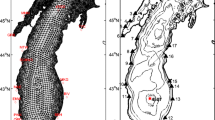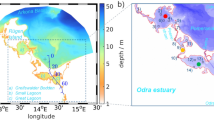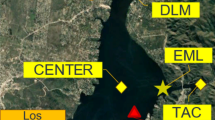Abstract
Many freshwater bodies worldwide that suffer from harmful algal blooms would benefit for their management from a simple ecological model that requires few field data, e.g. for early warning systems. Beyond a certain degree, adding processes to ecological models can reduce model predictive capabilities. In this work, we assess whether a simple ecological model without nutrients is able to describe the succession of cyanobacterial blooms of different species in a hypereutrophic reservoir and help understand the factors that determine these blooms. In our study site, Karaoun Reservoir, Lebanon, cyanobacteria Aphanizomenon ovalisporum and Microcystis aeruginosa alternatively bloom. A simple configuration of the model DYRESM-CAEDYM was used; both cyanobacteria were simulated, with constant vertical migration velocity for A. ovalisporum, with vertical migration velocity dependent on light for M. aeruginosa and with growth limited by light and temperature and not by nutrients for both species. The model was calibrated on two successive years with contrasted bloom patterns and high variations in water level. It was able to reproduce the measurements; it showed a good performance for the water level (root-mean-square error (RMSE) lower than 1 m, annual variation of 25 m), water temperature profiles (RMSE of 0.22–1.41 °C, range 13–28 °C) and cyanobacteria biomass (RMSE of 1–57 μg Chl a L−1, range 0–206 μg Chl a L−1). The model also helped understand the succession of blooms in both years. The model results suggest that the higher growth rate of M. aeruginosa during favourable temperature and light conditions allowed it to outgrow A. ovalisporum. Our results show that simple model configurations can be sufficient not only for theoretical works when few major processes can be identified but also for operational applications. This approach could be transposed on other hypereutrophic lakes and reservoirs to describe the competition between dominant phytoplankton species, contribute to early warning systems or be used for management scenarios.












Similar content being viewed by others
References
Akomeah E, Chun KP, Lindenschmidt K-E (2015) Dynamic water quality modelling and uncertainty analysis of phytoplankton and nutrient cycles for the Upper South Saskatchewan River. Environ Sci Pollut Res 22(22):18239–18251
Asaeda T, Pham HS, Nimal Priyantha DG, Manatunge J, Hocking GC (2001) Control of algal blooms in reservoirs with a curtain: a numerical analysis. Ecol Eng 16:395–404
Atoui A, Hafez H, Slim K (2013) Occurrence of toxic cyanobacterial blooms for the first time in Lake Karaoun, Lebanon. Water Environ J 27:42–49
Bastien C, Cardin R, Veilleux E, Deblois C, Warren A, Laurion I (2011) Performance evaluation of phycocyanin probes for the monitoring of cyanobacteria. J Environ Monit 13:110–118
Bruce LC, Hamilton D, Imberger J, Gal G, Gophen M, Zohary T, Hambright KD (2006) A numerical simulation of the role of zooplankton in C, N and P cycling in Lake Kinneret, Israel. Ecol Model 193:412–436
Burger DF, Hamilton DP, Pilditch CA (2008) Modelling the relative importance of internal and external nutrient loads on water column nutrient concentrations and phytoplankton biomass in a shallow polymictic lake. Ecol Model 211:411–423
Callieri C, Bertoni R, Contesini M, Bertoni F (2014) Lake level fluctuations boost toxic cyanobacterial “oligotrophic blooms”. PLoS One 9:e109526
Copetti, D., Tartari, G., Morabito, G., A. Oggioni, E.L.a.J.I., 2006. A biogeochemical model of Lake Pusiano (North Italy) and its use in the predictability of phytoplankton blooms: first preliminary results. J Limnol 65, 59–64
Cui Y, Zhu G, Li H, Luo L, Cheng X, Jin Y, Trolle D (2016) Modeling the response of phytoplankton to reduced external nutrient load in a subtropical Chinese reservoir using DYRESM-CAEDYM. Lake and Reservoir Manage 32(2):146–157
Fadel A (2014) Physico-chemical functioning and development of phytoplankton in Karaoun Reservoir (Lebanon): application of a hydrodynamic-ecological model (Doctoral dissertation, Université Paris-Est)
Fadel A, Atoui A, Lemaire B, Vinçon-Leite B, Slim K (2014a) Dynamics of the toxin cylindrospermopsin and the cyanobacterium Chrysosporum (Aphanizomenon) ovalisporum in a Mediterranean eutrophic reservoir. Toxins 6:3041–3057
Fadel A, Lemaire BJ, Atoui A, Vinçon-Leite B, Amacha N, Slim K, Tassin B (2014b) First assessment of the ecological status of Karaoun Reservoir, Lebanon. Lakes Reserv Res Manag 19:142–157
Fadel A, Atoui A, Lemaire BJ, Vinçon-Leite B, Slim K (2015) Environmental factors associated with phytoplankton succession in a Mediterranean reservoir with a highly fluctuating water level. Environ Monit Assess 187(10):1–14
Fadel A, Faour G, Slim K (2016) Assessment of the trophic state and chlorophyll-a concentrations using Landsat OLI in Karaoun Reservoir, Lebanon. Lebanese Sci J 17(2):130
Foy RH (1993) The phycocyanin to chlorophyll-a ratio and other cell components as indicators of nutrient limitation in two planktonic cyanobacteria subjected to low-light exposures. J Plankton Res 15:1263–1276
Gal G, Imberger J, Zohary T, Antenucci J, Anis A, Rosenberg T (2003) Simulating the thermal dynamics of Lake Kinneret. Ecol Model 162:69–86
Gal G, Hipsey MR, Parparov A, Wagner U, Makler V, Zohary T (2009) Implementation of ecological modeling as an effective management and investigation tool: Lake Kinneret as a case study. Ecol Model 220:1697–1718
Gkelis S, Moustaka-Gouni M, Sivonen K, Lanaras T (2005) First report of the cyanobacterium Aphanizomenon ovalisporum Forti in two Greek lakes and cyanotoxin occurrence. J Plankton Res 27:1295–1300
Hamilton DP, Schladow SG (1997) Prediction of water quality in lakes and reservoirs. Part I. Model description. Ecol Model 96:91–110
Hipsey MR (2007) Water quality modelling of west Seti hydropower reservoir using DYRESM-CAEDYM. The University of Western Australia, Australia
Hornung R (2002) Numerical modelling of stratification in Lake Constance with the 1-D hydrodynamic model DYRESM. Master Thesis, University of Stuttgart, Germany
Huisman J, Sharples J, Stroom JM, Visser PM, Kardinaal WEA, Verspagen JMH, Sommeijer B (2004) Changes in turbulent mixing shift competition for light between phytoplankton species. Ecology 85:2960–2970
Humphries SE, Lyne VD (1988) Cyanophyte blooms: the role of cell buoyancy. Limnol Oceanogr 33:79–91
Imberger J, Patterson JC (1981) A dynamic reservoir simulation model-DYRESM. In: Fischer HB (ed) Transport models for inland and coastal waters. Academic press, New York, pp 310–361
Imberger J, Patterson JC, Hebbert B, Loh I (1978) Dynamics of reservoir of medium size. J Hydraul Div ASCE 104:725–743
Istvanovics V (2010) Eutrophication of lakes and reservoirs. In: Likens GE (ed) Lake ecosystem ecology: a global perspective. Elsevier, Amsterdam
Janssen AB et al (2015) Exploring, exploiting and evolving diversity of aquatic ecosystem models: a community perspective. Aquat Ecol 49(4):513–548
Jørgensen SE (2010) A review of recent developments in lake modelling. Ecol Model 221:689–692
Kara EL, Hanson P, Hamilton D, Hipsey MR, McMahon KD, Read JS, Winslow L, Dedrick J, Rose K, Carey CC, Bertilsson S, da Motta Marques D, Beversdorf L, Miller T, Wu C, Hsieh Y-F, Gaiser E, Kratz T (2012) Time-scale dependence in numerical simulations: assessment of physical, chemical, and biological predictions in a stratified lake at temporal scales of hours to months. Environ Model Softw 35:104–121
Khemakhem H, Elloumi J, Ayadi H, Aleya L, Moussa M (2013) Modelling the phytoplankton dynamics in a nutrient-rich solar Saltern pond: predicting the impact of restoration and climate change. Environ Sci Pollut Res 20(12):9057–9065
Kling GW (1988) Comparative transparency, depth of mixing, and stability of stratification in lakes of Cameroon, West Africa. Limnol Oceanogr 33(1):27–40
Komárek J, Anagnostidis K (1999) Cyanoprokaryota 1 Teil: Chroococcales. In: Ettl H, Gärtner G, Heynig GH, Mollenhauer D (eds) Süßwasserflora von Mitteleuropa Band 19/1, Spektrum Akademischer Verlag
Komárek J, Anagnostidis K (2005) Cyanoprokaryota 2 Teil: Oscillatoriales. In: Büdel B, Gärtner G, Krienitz L, Schagerl M (eds) Süßwasserflora von Mitteleuropa Band 19/2, Spektrum Akademischer Verlag. Elsevier
Kozhevnikova IA, Shveikina VI (2014) Modeling level variations in Lake Kinneret. Water Res 41:627–633
Lampert W, Sommer U (2007) Limnoecology, the ecology of lakes and streams. Oxford University Press, New York
Lawson R, Anderson MA (2007) Stratification and mixing in Lake Elsinore, California: An assessment of axial flow pumps for improving water quality in a shallow eutrophic lake. Water Res 41(19):4457–4467
Lurling M, Eshetu F, Faassen EJ, Kosten S, Huszar VL (2013) Comparison of cyanobacterial and green algal growth rates at different temperatures. Freshw Biol 58:552–559
McDonald CP, Urban NR (2010) Using a model selection criterion to identify appropriate complexity in aquatic biogeochemical models. Ecol Model 221:428–432
Mieleitner J, Reichert P (2008) Modelling functional groups of phytoplankton in three lakes of different trophic state. Ecol Model 211:279–291
Mooij W, Trolle D, Jeppesen E, Arhonditsis G, Belolipetsky P, Chitamwebwa DR, Degermendzhy A, DeAngelis D, Senerpont Domis L, Downing A, Elliott JA, Fragoso C Jr, Gaedke U, Genova S, Gulati R, Hakanson L, Hamilton D, Hipsey M, 't Hoen J, Hulsmann S, Los FH, Makler-Pick V, Petzoldt T, Prokopkin I, Rinke K, Schep S, Tominaga K, Dam A, Nes E, Wells S, Janse J (2010) Challenges and opportunities for integrating lake ecosystem modelling approaches. Aquat Ecol 44:633–667
Naselli-Flores L, Barone R (1997) Importance of water-level fluctuation on population dynamics of cladocerans in a hypertrophic reservoir (Lake Arancio, south-west Sicily, Italy). Hydrobiologia 360:223–232
Patten BC, Egloff DA, Richardson TH (1975) Total ecosystem model for a cove in Lake Texoma. In: Patten BC (ed) System analysis and simulation in ecology. Academic Press, New York, pp 206–423
Paudel R, Jawitz JW (2012) Does increased model complexity improve description of phosphorus dynamics in a large treatment wetland?. Ecol Eng 42:283–294
Pollingher U, Hadas O, Yacobi YZ, Zohary T, Berman T (1998) Aphanizomenon ovalisporum (Forti) in Lake Kinneret, Israel. J Plankton Res 20:1321–1339
Rigosi A, Rueda FJ (2012) Propagation of uncertainty in ecological models of reservoirs: from physical to population dynamic predictions. Ecol Model 247:199–209
Rigosi A, Marcé R, Escot C, Rueda FJ (2011) A calibration strategy for dynamic succession models including several phytoplankton groups. Environ Model Softw 26:697–710
Rigosi A, Hanson P, Hamilton DP, Hipsey M, Rusak JA, Bois J, Sparber K, Chorus I, Watkinson AJ, Qin B, Kim B, Brookes JD (2015) Determining the probability of cyanobacterial blooms: the application of Bayesian networks in multiple lake systems. Ecol Appl 25:186–199
Rinke K, Yeates P, Rothhaupt K-O (2010) A simulation study of the feedback of phytoplankton on thermal structure via light extinction. Freshw Biol 55:1674–1693
Robson BJ, Hamilton DP (2004) Three-dimensional modelling of a Microcystis bloom event in the Swan River estuary, Western Australia. Ecol Model 174:203–222
Robson BJ (2014) When do aquatic systems models provide useful predictions, what is changing, and what is next?. Environ Model Softw 61:287–296
Romero JR, Antenucci JP, Imberger J (2004) One-and three-dimensional biogeochemical simulations of two differing reservoirs. Ecol Model 174(1):143–160
Sarnelle O (2007) Initial conditions mediate the interaction between Daphnia and bloom-forming cyanobacteria. Limnol Oceanogr 52:2120–2127
Slim K, Fadel A, Atoui A, Lemaire BJ, Vinçon-Leite B, Tassin B (2014) Global warming as a driving factor for cyanobacterial blooms in Lake Karaoun, Lebanon. Desalin Water Treat 52:2094–2101
Smith VH (2003) Eutrophication of freshwater and coastal marine ecosystems: a global problem. Environ Sci Pollut Res 10(2):126–139
Smith VH, Bierman VJ, Jones BL, Havens KE (1995) Historical trends in the Lake Okeechobee ecosystem. IV. Nitrogen: phosphorus ratios, cyanobacterial dominance, and nitrogen fixation potential. Archiv fur Hydrobiologie-Supplementband Only 107(1):71–88
Spigel RH, Imberger J, Rayner KN (1986) Modeling the diurnal mixed layer. Limol Oceanogr 31:533–556
Stull RB (1988) An introduction to boundary layer meteorology. Kluwer Academic Publishers, Dordrecht
Takkouk S, Casamitjana X (2015) Application of the DYRESM–CAEDYM model to the Sau Reservoir situated in Catalonia. Desalin Water Treat 57(27):12453–12466
Tanentzap AJ, Hamilton D, Yan ND (2007) Calibrating the dynamic reservoir simulation model (DYRESM) and filling required data gaps for one-dimensional thermal profile predictions in a boreal lake. Limnol Oceanogr: Methods 5:484–494
Temsah M, Tarhini K, Fadel A, Slim K (2016) Effect of irrigation with lake water containing cylindrospermopsin toxin on seed germination and seedlings growth of Cucumis sativus and Lycopersicon esculatum. Int J Sci: Basic Appl Res 27(3):108–122
Tennessee Valley Authority (1972) Heat and mass transfer between a water surface and the atmosphere. Water Resources Research Laboratory Report 14, Report No. 0–6803
Tian C, Pei H, Hu W, Hao D, Doblin MA, Ren Y, Wei J, Feng Y (2015) Variation of phytoplankton functional groups modulated by hydraulic controls in Hongze Lake, China. Environ Sci Pollut Res 22(22):18163–18175
Trolle D, Jørgensen TB, Jeppesen E (2008) Predicting the effects of reduced external nitrogen loading on the nitrogen dynamics and ecological state of deep Lake Ravn, Denmark, using the DYRESM-CAEDYM model. Limnol - Ecol Manag Inland Waters 38:220–232
Trolle D, Hamilton D, Hipsey M, Bolding K, Bruggeman J, Mooij W, Janse J, Nielsen A, Jeppesen E, Elliott JA, Makler-Pick V, Petzoldt T, Rinke K, Flindt M, Arhonditsis G, Gal G, Bjerring R, Tominaga K, Hoen Jt, Downing A, Marques D, Fragoso C Jr, Sondergaard M, Hanson P (2012) A community-based framework for aquatic ecosystem models. Hydrobiologia 683:25–34
USAID (2012) Litani River basin managemWatersent support program. Feasibility study for constructed wetlands in the Litani River basin. Washington, DC
Valdespino-Castillo P, Merino-Ibarra M, Jiménez-Contreras J, Castillo-Sandoval F, Ramirez-Zierold JA (2014) Community metabolism in a deep (stratified) tropical reservoir during a period of high water-level fluctuations. Environ Monit Assess 186:6505–6520
Vieira J, Fonseca A, Vilar VJP, Boaventura RAR, Botelho CMS (2013) Water quality modelling of Lis River, Portugal. Environ Sci Pollut Res 20(1):508–524
Wang W, Liu Y, Yang Z (2010) Combined effects of nitrogen content in media and Ochromonas sp grazing on colony formation of cultured Microcystis aeruginosa. J Limnol 69:193–198
Wantzen K, Rothhaupt K-O, Mortl M, Cantonati M, G.-Toth L, Fischer P (2008) Ecological effects of water-level fluctuations in lakes: an urgent issue. Hydrobiologia 613:1–4
Watras CJ, Baker AL (1988) Detection of planktonic cyanobacteria by tandem in vivo fluorometry. Hydrobiologia 169:77–84
Weinberger S, Vetter M (2012) Using the hydrodynamic model DYRESM based on results of a regional climate model to estimate water temperature changes at Lake Ammersee. Ecol Model 244:38–48
Yeates PS, Imberger J (2003) Pseudo two-dimensional simulations of internal and boundary fluxes in stratified lakes and reservoirs. Int J River Basin Manage 297-319
Zhang X, Warming TP, Hu H-Y, Christoffersen KS (2009) Life history responses of Daphnia magna feeding on toxic Microcystis aeruginosa alone and mixed with a mixotrophic Poterioochromonas species. Water Res 43:5053–5062
Zhou J, Qin B, Casenave C, Han X, Yang G, Wu T, Wu P, Ma J (2015) Effects of wind wave turbulence on the phytoplankton community composition in large, shallow Lake Taihu. Environ Sci Pollut Res 22(16):12737–12746
Zhu X, Wang Q, Lu Z, Liu J, Zhu C, Yang Z (2015) Offspring performance of Daphnia magna after short-term maternal exposure to mixtures of microcystin and ammonia. Environ Sci Pollut Res 22(4):2800–2807
Zohary T, Ostrovsky I (2011) Ecological impacts of excessive water level fluctuations in stratified freshwater lakes. Inland Waters 1(1):47–59
Author information
Authors and Affiliations
Corresponding author
Additional information
Responsible editor: Vitor Manuel Oliveira Vasconcelos
Rights and permissions
About this article
Cite this article
Fadel, A., Lemaire, B.J., Vinçon-Leite, B. et al. On the successful use of a simplified model to simulate the succession of toxic cyanobacteria in a hypereutrophic reservoir with a highly fluctuating water level. Environ Sci Pollut Res 24, 20934–20948 (2017). https://doi.org/10.1007/s11356-017-9723-9
Received:
Accepted:
Published:
Issue Date:
DOI: https://doi.org/10.1007/s11356-017-9723-9




